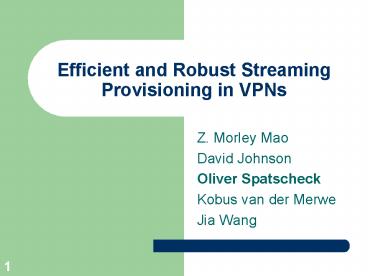Efficient and Robust Streaming Provisioning in VPNs PowerPoint PPT Presentation
1 / 25
Title: Efficient and Robust Streaming Provisioning in VPNs
1
Efficient and Robust Streaming Provisioning in
VPNs
- Z. Morley Mao
- David Johnson
- Oliver Spatscheck
- Kobus van der Merwe
- Jia Wang
2
Motivation
- Live streaming in VPNs increasingly popular
- E.g., CEO-employee town hall meeting
- Lack of layer 3 multicast
- Requires unicast streaming
- Wide-area bandwidths are expensive and easily
congested - Solution proposal
- Streaming cache servers
3
What are VPNs?
- Virtual private networks
- Connect remote locations of large companies
- Implemented using technologies such as Frame
Relay, MPLS, or IPSEC - Requires
- privacy
- performance isolation from public Internet
- Typically hub and spoke topologies
4
Hub and spoke topology
5
Problem statement
- What are the minimum number of cache servers and
their placement to deliver unicast streaming
content to a given population? - We prove the problem is NP hard
- How to place the cache servers to minimize total
bandwidth usage?
6
Assumptions for the General Case
- Known network
- topology, link capacity, user location
- Known origin server, bandwidth of the stream
- Request routing from any cache server
- Cache location at any router
- Application requirement
- Bandwidth is the critical resource
- Bandwidth usage cannot exceed link capacity
- Sufficient server capacity
- VPN topology hub and spoke
7
Redirection overview
Increasing implementation complexity, But fewer
cache servers
- Interception based
- Clients request from origin server
- Caches intercept requests
- Optimal greedy algorithm O(V)
- Router based redirection
- Clients connected to the same router request
- from the same server
- O(V2E)
- Client based redirection
- Each client can request from a different cache
- Flow-based redirection
- End to end routing controlled
8
Interception proxy algorithm
- Greedy algorithm
- Walk the tree from the leave nodes to the root
- At each depth, place a cache at overloaded nodes
- Overloaded node
- Demand from children exceed incoming link
capacity - Assigns the minimum number of caches assuming
flows are restricted to the distribution tree T
built from the origin server - Running time
- O(V) visit each link once.
- Algorithm is optimal for interception proxies
9
Interception proxy algorithm
10
Interception proxy algorithm --Minimizing
bandwidth
- Greedy gives minimum number of caches
- Flows restricted to original tree
- Bandwidth can be reduced
- By pushing caches towards leaves
- Algorithm is optimal interception proxies
11
Router based redirection
- Algorithm
- Calculate for each overloaded node its merit
value - Merit based on how many overloaded nodes it can
alleviate if there is a cache placed there - Requirement all hosts of the same router need to
request from the same cache - Walk the tree from leaf nodes to root
- Pick the node at each depth with the max merit
- O(V2E)
12
Router based redirection
13
Client based redirection
- Relax the requirement of router based redirection
- Each client can choose its own cache server
- More fine grained redirection
14
Client based redirection
15
Flow based algorithm
- All existing algorithms use IP routing
- Certain links may be underutilized
- Assume controlled end-to-end routing
- Through MPLS, OSPF weight setting
- Algorithm
- Given Greedys cache placement
- Try to delete each cache and test for max flow
- Delete if demand satisfied
16
Local exhaustive search
- General problem is NP-hard
- Exhaustive search takes exponential time
- Infeasible for large topologies
- Local exhaustive provides an upper bound
- Assume every hub node contains a cache
- Exhaustively search each stub network
- Sum up total number of caches
- Assumes controlled end-to-end routing
17
Results overview
- Simulation methodology
- Algorithms implemented on typical hub-spokes
- Three classes of VPNs large companies, retail
stores, engineering firms - Simulator based on GT-ITM topology generator,
Stanford GraphBase - Empirical error distribution for link capacity
estimates - Based on 600 measurements using Java and activeX
based client side measurement tools
18
Compare the algorithms
19
Effect of multihoming
20
Error resilience
21
Concluding remarks
- Study the problem of cache server placement in
VPNs for unicast based streaming - Developed provably optimal algorithm
- Minimum number of caches
- Minimum total bandwidth usage
- Assuming interception based algorithm
- General problem is NP-hard
- Router based redirection
- Client based redirection
- Flow based algorithm very close to optimal
22
Related work
- Cache placement for web traffic
- Server placement in overlay networks
- Assumptions of previous work
- Ignoring network constraints
- Main distinction of our work
- VPN environment
- Minimum number of caches for a known user
population - Consideration of robustness of algorithm in face
of imperfect input data
23
Extras
24
Effect of spoke domain size
25
Error resilience using robust algorithm

